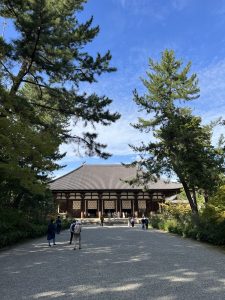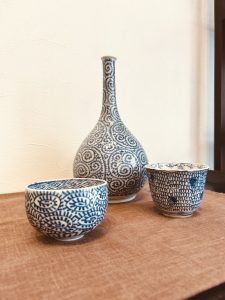みなさまこんにちは、スタッフYでございます。
10月に入りすこし出かけやすくなってきまして。今しかない!と、このところ、そそくさと出かけております。
先日、急に思い立った奈良弾丸ドライブ、薬師寺の東塔を拝見し、そこからふらふらと歩きながらお隣のお寺へ行って参りました。
「唐招提寺」
久しぶりの訪問です。

御朱印帳こそ集めておりませんがこれまで有名無名まあまあの神社仏閣を訪れておりまして、いろいろ訪れたお寺さんのなかで私の勝手に大好きなお寺ランキング第一位に輝くお寺であります。どこに惹かれるのか?といいましても、なかなか一言では語りつくせませんが、鑑真和上を含めこのお寺の佇まい全部でしょうか。

少しおさらいをいたしますと、唐招提寺は、南都六宗の一つである律宗の総本山であります。多くの苦難の末、来日をはたされた鑑真大和上は、東大寺で5年を過ごした後、新田部親王の旧宅地(現在の奈良市五条町)を下賜されて、天平宝字3年(759)に戒律を学ぶ人たちのための修行の道場を開かれました。「唐律招提」と名付けられ鑑真和上の私寺として始まった当初は、講堂や新田部親王の旧宅を改造した経蔵、宝蔵などがあるだけでしたが、金堂は8世紀後半、鑑真和上の弟子の一人であった如宝の尽力により、完成したといわれております。そして現在では、奈良時代建立の金堂、講堂が天平の息吹を伝える、貴重な伽藍となっています。
そんな山門をくぐり、屋根に輝く天平の甍を仰ぎ見ながら金堂へ向かって歩きます。空気そのものがすでに奈良時代へとかわってくるようです。そして、鑑真和上もこの山門をくぐりこの西ノ京の空を眺めていたのかと思いますと、自分までもが既に天平時代の人間になったつもりになってゆっくりと金堂へと足をすすめておりました。
正面の金堂にてまずは参拝。金堂内は、中央に本尊・盧舎那仏坐像、右に薬師如来立像、左に千手観音立像(いずれも国宝)が。この金堂のなかこそ天平時代を彷彿させる厳かな雰囲気に包まれておりますが、その存在もそうなのですが、自分はその精巧な造りそのものにいつも圧倒され、悟りとか自分を見つめるとか、そういった難しいことなどは考えられません。写真は撮れませんので、大きな像のその細やかな細工などのひとつひとつをじっと見つめて辿っていくことで精いっぱいであります。

ことに、千手観音像のアイテム(失礼しました。)にいつも心を奪われておりまして、高さ5.36mの立像のその大脇手42本、小脇手911本、合わせて953本の腕一つ一つに何を携えているのか、今回も食い入るように覗き込んでおりました。そばでみますとちょっと変な人なのですが、本来は1000本あったと考えられてた手は果たしてどこにあったのか…なんて考えながら、あのバランスよく配され不自然さを感じさない多くの手に、そして全体的にのびやかな印象とすずし気な目鼻立ちに、千手観音像に癒されるといいますか、いつもわくわくした高揚感をいただいております。
そんな金堂を始め、唐招提寺はまさに国宝の宝庫。
そんな中、私がとくに好きな建物がこちらなのですが。

宝蔵(8世紀奈良時代)校倉・寄棟造・本瓦

経蔵(8世紀奈良時代)校倉・寄棟造・本瓦
こちらの宝蔵・経蔵は、この2つの建築はいずれも正倉院などと同様に奈良時代の校倉造の建築であり、国宝にも指定されているという大変貴重なものとなっています。
2つの違いとしては、宝蔵の方がやや経蔵よりも大きな建築となっているほか、建設時期としては宝蔵が唐招提寺創建時に建設されたものである一方、経蔵は唐招提寺が建設される前、この地が貴族の邸宅であった時代から存在するなど一層古いものであるとされ、唐招提寺創建以前の新田部親王邸の米倉を改造したものであります。
ですので経蔵は東大寺正倉院の校倉よりも更に古い日本最古の校倉造建築であるとも言われています。ちなみに現在はいずれも寄棟造となっていますが、経蔵はかつては切妻造であったとされており、途中で改修が施されたことが伺えます。
正倉院を拝観された方でしたらわかると思いますが、正倉院は厳重に守られた環境で、しかも遠くからどちらかというと眺めることしかできない拝観でしょうか。こちらの唐招提寺の宝蔵・経蔵はなんと、ぎりぎりまで近くによってみることが出来ますので、かなりテンションあがります。
正倉院に比べますと、とても小さい蔵ではありますが、この小ささもまた私のテンションをくずぐります。かわいい。(失礼しました。)小さな蔵でありますが、これまで大切に大切に保存されてきたのかと思いますと、守っていきたいと願った何千年ものこれまでのたくさんの人たちの気持ちは、この小さな蔵から伝わってきます。そんなことを考えながらしばらく眺めておりました。

なぜか無性に訪れたくなる大好きなお寺、唐招提寺。今回も心置きなく堪能いたしました。
それでは、ごきげんよう。

Hello everyone, this is Staff Y.
It’s October and it’s getting a little easier to go out. It’s now or never! I have been going out quickly these days.
The other day, I had a sudden idea to go for a drive around Nara. I visited the East Pagoda of Yakushiji Temple and then went to a neighboring temple on foot.
Toshodaiji Temple.
It has been a long time since I visited this temple.
Although I do not collect red seal books, I have visited many temples and shrines, both famous and obscure, and this temple ranks first in my favorite temples among those I have visited. What attracts me to this temple? It is difficult to describe in a few words, but I think it is the whole appearance of the temple, including the presence of Ganjin Wajo.
Toshodaiji Temple is the head temple of the Ritsu sect, one of the six sects of the Southern Capital. After spending five years at Todaiji Temple, he was given the former residence of Prince Nittabe (now Gojo-machi, Nara City) as a gift, and in 759, he opened a training center for those studying the Buddhist precepts. When the temple was named “Tang-ryu-sho” and started as a private temple of Ganjin Wajo, it had only an auditorium, a sutra library converted from the former residence of Prince Shintabe, and a treasure house, etc. The Kondo hall was completed in the late 8th century through the efforts of Nyoho, one of Ganjin’s disciples. Today, the Kondo and the lecture hall, built in the Nara period, are a valuable temple complex that conveys the spirit of the Tenpyo period.
Passing through the gate and looking up at the shining roofs of Tenpyo-era buildings, visitors walk toward the Kondo Hall. The air itself seems to have already changed to that of the Nara period. I wondered if Ganjin Wajo had passed through the gate and looked up at the sky of Nishinokyo, and I slowly made my way to Kondo as if I were a person of the Tenpyo period.
First, we prayed at the main Kondo hall. Inside the main hall, there is a seated statue of Rushanabutsu in the center, a standing statue of Yakushi Nyorai on the right, and a standing statue of Senju Kannon (both national treasures) on the left. The Kondo is surrounded by a solemn atmosphere reminiscent of the Tenpyo period, and I am always overwhelmed by the elaborate structure itself, as well as its presence, and cannot think about such difficult things as enlightenment or looking at myself. Since I cannot take photographs, I am occupied with following the intricate workmanship of the large statues one by one.
I am always fascinated by the items of the Thousand-Armed Avalokitesvara Bodhisattva. I was always fascinated by the items of the 5.36-meter-tall statue of the Thousand-Armed Kannon, and this time again I was peering intently at each of its 953 arms (42 large side arms and 911 small side arms) to see what they were carrying. He looks a little strange when you look at him up close, but I wondered where the 1,000 hands that were originally thought to have been there really were… I was also impressed by the well-balanced arrangement of the many hands that did not seem unnatural, and the overall impression of spontaneity and graceful eyes and noses, The statue of the thousand-armed Avalokitesvara heals me, and I always feel excited and uplifted.
Starting with Kondo, Toshodaiji Temple is a treasure house of national treasures.
Among them, I particularly like this building.
Treasure house (8th century, Nara period): a storehouse with a hipped roof and a main roof tile
Sutra Repository (8th century, Nara period), storehouse, hipped roof, brick roofing
The two buildings, the Hozo and the Sutra Repository, are very valuable because, like the Shosoin Temple, they were both built in the Nara period (710-794) and are designated as national treasures.
The difference between the two is that the Hozo is slightly larger than the Sutra Repository, and while the Hozo was built at the time of Toshodaiji’s construction, the Sutra Repository is said to be older, having existed since the time when the area was a nobleman’s residence, before Toshodaiji was built. It is believed to be even older, having existed since the days when this area was a nobleman’s residence before Toshodaiji was built.
It is said that the Sutra Repository is Japan’s oldest storehouse structure, even older than the storehouse in Todaiji’s Shosoin. The Kyozo is said to have once been a gabled gable structure, although it is now a hipped-roofed structure, indicating that it was remodeled during its construction.
As those who have visited the Shosoin Temple will understand, the Shosoin Temple is a very strictly guarded environment, where one can only view the treasures from a distance. The Treasure House and Sutra Repository at Toshodaiji Temple are very close to the Shosoin, so it is quite exciting to see them.
Compared to the Shosoin, it is a very small storehouse, but this smallness also makes me excited. It is cute. (Sorry, I’m sorry…). Although it is a small storehouse, I think that it has been carefully and carefully preserved, and I can feel the feelings of many people who have wished to protect it for thousands of years from this small storehouse. I looked at it for a while while thinking about this.
Toshodaiji Temple is one of my favorite temples, which I have an irresistible urge to visit for some reason. I enjoyed it again this time without any worries.
I wish you all the best.
*******************
ご実家の整理やお片付けなどをされている方のご相談などが多くございます。
お片付けなどくれぐれもご無理のないようになさってくださいませ。
風光舎では古美術品や骨董品の他にも絵画や宝石、趣味のお品など様々なジャンルのものを買受しております。
お片付けをされていて、こういうものでもいいのかしらと迷われているものでも、どうぞお気軽にご相談下さいませ。
また風光舎は、出張買取も強化しております。ご近所はもちろん、愛知県内、岐阜県、三重県その他の県へも出張いたします。
まずは、お電話お待ちしております。
愛知県名古屋市千種区姫池通
骨董 買取【古美術 風光舎 名古屋店】
TEL052(734)8444
10:00-17:00 OPEN
#出張買取#骨董#古美術#骨董品#絵画#版画#茶道具#刀剣#彫刻

































